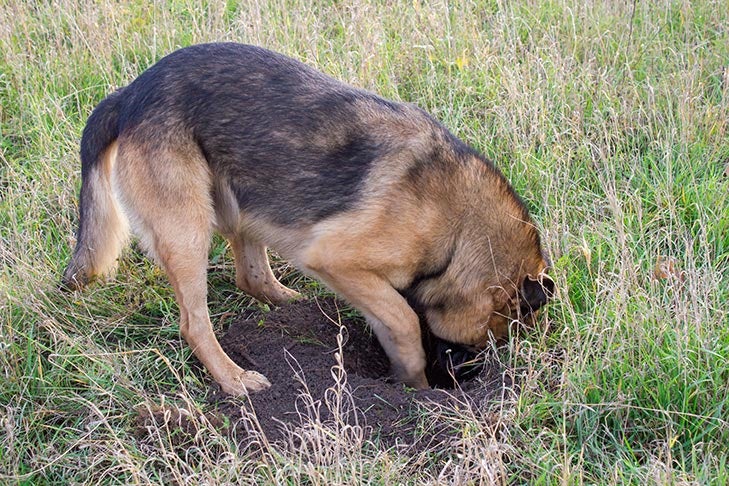
Spring is here, and while you and your dog might be excited about the warmer weather, there is more to the season than meets the eye. You want to give your dog the best care possible, and to prepare for seasons like spring, there are some things you’ll want to consider. Is your pet on heartworm medication? Are they regularly taking flea and tick medication? How do you correct digging behavior, and what do you do if your dog shows signs of spring allergies? Learn more about how to help your dog have the best spring yet and cover all the bases.
Heartworm, Fleas and Ticks
As with all medical issues, it is better to prevent problems than to have to treat them later. Check with your veterinarian for preventive recommendations against heartworm and fleas/ticks to keep your dog in good health.
Heartworm disease is a serious and potentially fatal parasitic disease transmitted by mosquitoes. There are a variety of options for preventing heartworm infection in dogs; talk to your veterinarian about the right one for your dog. American Heartworm Society guidelines recommend that all dogs be tested annually for heartworm infection.
Fleas and ticks can cause a host of problems, from flea allergy dermatitis (FAD) to Lyme disease and Rocky Mountain Spotted Fever. In large enough numbers, both ticks and fleas can cause dangerous amounts of blood loss, especially in young dogs. The most common flea and tick prevention options — monthly spot-on topicals, and oral tablets — are popular primarily due to their convenience and effectiveness.
Spring Allergies
Blooming plants, grasses and flowers can trigger atopy, an allergy similar to hay fever. But instead of sneezing, a dog typically develops itchy skin and will persistently scratch, lick and bite himself to get relief. As with humans, the allergy is an inherited predisposition. If signs of atopy occur for less than three months out of the year, oral medications may be used to control itching. In more severe cases, your vet can perform a skin test to pinpoint the allergies. Visit your veterinarian for recommended allergy treatments if you suspect that your pooch may be suffering from seasonal allergies.

Why Your Dog Might Smell
Your furry friend may have acquired an unpleasant odor due to any number of reasons: dental disease, ear infection, oily skin, or a blocked anal gland. First, learn where the smell is coming from. Mouth odor could indicate dental problems, digestive illness or underlying internal diseases, such as a kidney ailment or diabetes.
If his teeth are discolored or the odor is worse than his usual doggie breath, have your vet perform a dental exam. Next, check his ears. If the skin inside is red or sore, if the ear has a bad odor, or if your dog reacts in pain when you examine his ears, have your vet check him for an ear infection. Next step is to check your dog’s skin for the common disorder seborrhea, usually characterized by flaky dandruff or an oily, waxy feel to the coat and a strong odor. The odor can be prevented by frequently bathing your dog with a medicated shampoo. Lastly, an infected anal gland can also lead to odor and discomfort, in which case your dog will need veterinary attention.
Garden Hazards and Digging
Our inquisitive dogs might see fragrant spring blooms as a tasty snack to munch. Dogs can become extremely ill or even die from eating poisonous plants or flowers. Ask your vet for a list of plants to avoid. To help prevent your dog from eating plants, don’t garden with him present — otherwise he may conclude that playing with plants and digging are acceptable activities. If any lawns you encounter have been treated with fertilizers, herbicides or insecticides, don’t let your dog walk on them until these often toxic treatments have dried completely.

Enjoy the Outdoors and Reinforce Training
In addition to the above health and safety tips, take advantage of the longer days and warmer temperatures to refresh your training skills and build on your relationship with your dog. Remember that we all tend to hibernate a little over the winter. Spring is an invitation to renew our commitment to exercise and a more active lifestyle for ourselves and our dogs. After a long winter, your dog may have forgotten his manners about walking properly on leash. Start out slowly and reestablish the proper leash rules for you and you r dog’s safety. Use basic obedience disciplines to help reinforce the relationship you want to have with your dog. Walking to heel, coming when called, and gate manners are some of the basics that can sharpen your dog’s response to you and build a stronger relationship.
Springtime should be fun for everyone. By taking these precautions, you and your dog can have a great season! Find a dog trainer near your location and take the Canine Good Citizen test for your dog.

